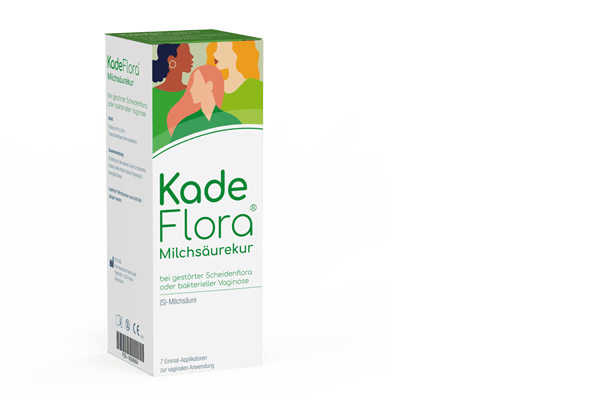Bacterial vaginosis: – That is why a visit to the gynaecologist is inevitable
Bacterial vaginosis is one of the most common diseases of the vagina. Many women have never heard of the disease. It is, however, very common and usually requires treatment with prescription antibiotics. A doctor’s visit is therefore inevitable.
How does bacterial vaginosis develop?
Bacterial vaginosis occurs when certain pathogens multiply in the vagina excessively, creating an imbalance. In most cases, these are bacteria of the Gardnerella vaginalis species. They may be present in small numbers in the vagina of healthy women without causing illness. This is ensured by the natural vaginal flora, which in a healthy state prevents spread of pathogens. The intimate flora mainly consists of so-called lactic acid bacteria (lactobacilli). These provide an acidic milieu in the vagina, i.e. a low pH (between 3.8 and 4.5).
Since many pathogens do not feel comfortable in an acidic environment, the vaginal flora thus offers some protection. However, the vaginal flora is sensitive: it can be weakened, above all, by stress. Accordingly, mental strain is one of the main causes of bacterial vaginosis. However, the female hormones also affect the vaginal milieu. Fluctuations in the hormonal balance, for example, occur every month during the menstrual cycle. Especially during or shortly after menstruation, the vaginal defence is somewhat weaker. Hormone fluctuations, especially in phases of life such as puberty, pregnancy or during the menopause, also play a role. Women are therefore often somewhat more susceptible to vaginal yeast infections or vaginal bacterial infections during these times.
If the beneficial bacteria in the vagina are no longer able to provide a healthy acidic environment, the pH increases. Unwanted bacteria take advantage of this condition: They multiply excessively and trigger complaints.
4 tips
for preventing bacterial vaginosis
Clean your intimate area gently with a special intimate wash lotion or with water only to avoid disturbing the natural milieu.
Refrain from intimate deodorants or vaginal douches – these too disrupt the natural balance.
Change pads and tampons regularly.
After a bowel movement, please always wipe from your anus towards the back – and never in the opposite direction!
Typical for bacterial vaginosis: Unpleasant odour and watery discharge
The symptoms of bacterial vaginosis are very unpleasant for most women. Some also fear a sexually transmitted infection and are afraid to talk about it. This is, however, not the case as the bacteria causing bacterial vaginosis are not sexually transmissible. Affected women can neither be blamed for the disease, nor are the symptoms a sign of poor personal hygiene. What many women also don’t know: Bacterial vaginosis is the most common disorder of the vaginal milieu caused by bacteria. You should therefore always speak openly to your doctor if you notice the following symptoms:
- increased watery discharge and/or
- an unpleasant fishy smell in the genital area.
When experiencing complaints in the genital area, women are often unsure whether it could be vaginal yeast infection. However, symptoms of bacterial vaginosis can be easily distinguished from a yeast infection: Vaginal yeast infection is associated with a prominent itching and burning in the intimate area. This is rarely the case with bacterial vaginosis. Furthermore, the vaginal discharge associated with vaginal yeast infection is odourless.
The distinction is important since women can usually treat a vaginal yeast infection themselves, while bacterial vaginosis always requires a doctor’s visit.
How do you contract Gardnerella bacteria?
The most frequent cause of bacterial vaginosis are bacteria of the Gardnerella vaginalis species. These bacteria usually inhabit the intestine. They can easily spread from the intestine to the vagina through smear infection. This can happen, for example, when wiping back to front after defecation.
The bacteria can also easily bridge the short distance from the intestine to the vagina during sexual intercourse. This can sometimes already happen when the penis is inserted into the vagina – although the risk is particularly hight when switching from anal to vaginal intercourse. In order to prevent vaginal infections, you should avoid this variant.
Why women should always visit a doctor in the event of bacterial vaginosis
You should always visit a gynaecologist if you suspect a bacterial vaginosis. But don’t worry: The disease is well treatable. This, however, can only be done using prescription-only drugs. Suitable antibiotics are ones with active ingredients such as metronidazole or clindamycin. The uncomfortable symptoms usually disappear shortly after starting the treatment. Nevertheless, the therapy has a catch: Antibiotics don’t just kill the unwanted pathogens. They also harm the body’s own lactic acid bacteria, which protect the genital area.
In order to rebuild a stable vaginal flora and prevent relapse, an accompanying 7-day lactic acid treatment has proven effective. The KadeFungin lactic acid treatment (KadeFungin Milchsäurekur) helps to quickly rebuild the vaginal flora after a vaginal infection. The treatment
- relieves symptoms such as unpleasant odour and excessive discharge,
- stabilises the vaginal flora and supports the treatment of bacterial vaginosis,
- can also be used during pregnancy
What to do during pregnancy?
Especially during pregnancy, vaginal infections are not uncommon. A vaginal yeast infection can occur more frequently during pregnancy. It is similar with bacterial vaginosis: After all, every fifth to tenth pregnant woman suffers from it. The reason for this is as follows: The changed hormone balance also affects the environment of the vagina. In addition, the immune system of pregnant women is more sensitive, so infections can generally occur more quickly. Although bacterial vaginosis during pregnancy is not uncommon, a gynaecologist must always be consulted.
If left untreated, it can increase the risk of premature labour pains and premature rupture of the amniotic sac. This ultimately increases the risk of premature birth. Bacterial vaginosis during pregnancy also increases the risk of miscarriage.
Bacterial vaginosis: How can I prevent it?
There are many reasons for a disturbed vaginal flora. A bacterial vaginosis can therefore not always be prevented. However, there are some measures you can take to lower the risk. In this context, for example, a good immune system plays an important role. Those suffering frequently from stress and eating unhealthily are generally at a higher risk for disease. You can therefore contribute to stable health by avoiding stress or reducing it as much as possible. Many women accomplish this by, for example, practising sports. Regular exercise outdoors, such as jogging or Nordic walking, is particularly beneficial and supports your immune system.
Proper intimate hygiene also helps to protect the genital area against infections:
- Clean the genital area gently, preferably using just clean water.
- If you are not comfortable with water alone, use only mild washing lotions with a pH that corresponds to that of the intimate area.
- Exaggerated hygiene measures damage the intimate flora: Refrain therefore from intimate deodorants or vaginal douching.
- Change tampons or pads regularly during your period.
- Always wipe from front to back after a bowel movement – this way, no bacteria are carried over from the intestine to the vagina.
KadeFungin products for bacterial vaginosis?
The KadeFungin lactic acid treatment (KadeFungin Milchsäurekur) has proven effective in supporting the vaginal flora and preventing relapse. When applied about two to three days after your period, it stabilises and strengthens your intimate flora.
KadeFungin lactic acid treatment
with lactic acid
- treats vaginal discharge and intimate odour associated with bacterial vaginosis*
- reduces the risk of recurrent urinary tract infections
- normalises the pH, also during pregnancy
* For bacterial vaginosis, as a supplement to an antibiotic (supportive treatment) or for known, mild symptoms as single therapy (alternative treatment to an antibiotic)




